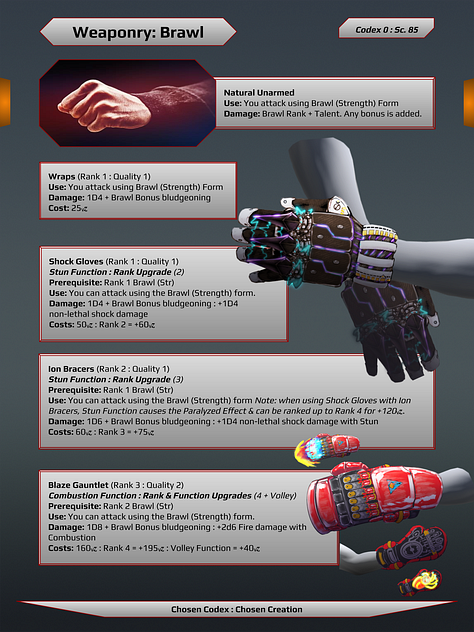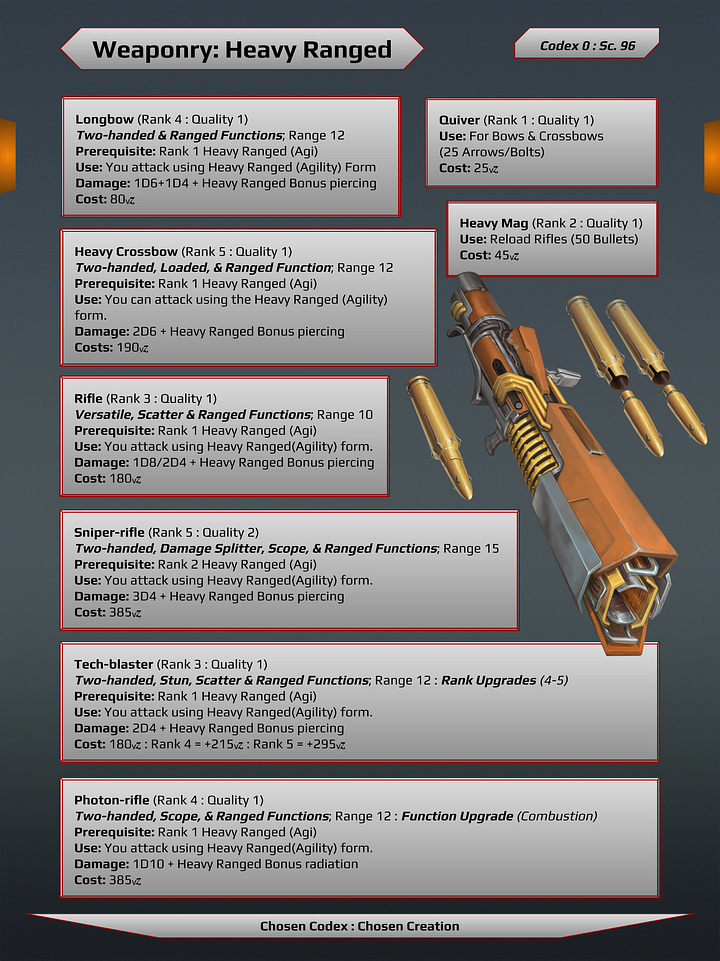Gear Phase: Chosen Creation
Enter into the Shopping Phase of Chosen Creation, and gear up your Chosen for your Reborn in Power Campaign!
Aside from the Access that you may be eyeing, there are other ways to become a formidable adversary across the realms. The most common way is through the mastery of your Gear!
In this Phase, you will be going shopping! You will begin by Choosing your starting Gear, which is given to you by your Origin Path, and spending any Voltz that you may have to start.
See the Origin Phase for more information.
Gear Archive:
When exploring the CORE Realms, you will be able to acquire Gear Pieces that will assist you in your endeavors.
To understand how each piece works you will need to Rank up specific Universals that the Gear requires as a prerequisite. If you are not the specified Rank your Loremaster (LM) will ask for the specified check in order to use the piece.
Gear Categories:
All Gear Pieces can be found in the following categories:
Gear Mechanics:
Each Gear Piece has a design to it for you to understand how they operate. Here is that design!
Gear Piece Name (Rank # : Quality #)
Function(s)/Slot Type : Rank/Function Upgrades
Prerequisite(s): Rank of a Universal = Quality of the Gear Piece
Use: This is a detailed description of how you would use the Gear Piece.
Damage/Guard/Heal/Utility: These would be different types of descriptions for Damage, Guarding, Healing, and Functions.
Cost: This would be the amount of Voltz it would take to obtain and upgrade the Gear Piece.
Rank:
When it comes to the entire Reborn in Power system, understanding how ranking works is one of the fundamental rulings that will set you aside from beginners. Gear is only 1 of 6 other aspects of RIP that utilizes the Ranking System.
There are 2 ways for Chosen to rank up gear, the first is through buying upgrades using Voltz (Note: As long as there is an upgrade to buy for it), or the second is using a Repair Station with Upgrade Materials to rank it up yourself. The ladder is a bit riskier as you may destroy the weapon outright. Be sure to keep track of Ranks as they determine the strength of a Gear piece.
Rank 1: Has a +5ᵥ𝒛 increase to the base Quality, with a 1D4 Gear Rank Die. The SD to use a Craft (Int) Knowledge Check increases the base by +2.
Rank 2: Has a +10ᵥ𝒛 increase to the base Quality, with a 1D6 Gear Rank Die. The SD to Craft (Int) Knowledge Check increases the base by +3.
Rank 3: Has a +30ᵥ𝒛 increase to the base Quality, with a 1D8 Gear Rank Die. The SD to Craft (Int) Knowledge Check increases the base by +4.
Rank 4: Has a +120ᵥ𝒛 increase to the base Quality, with a 1D10 Gear Rank Die. The SD to Craft (Int) Knowledge Check increases the base by +5.
Rank 5: Has a +600ᵥ𝒛 increase to the base Quality, with a 1D12 Gear Rank Die. The SD to Craft (Int) Knowledge Check increases the base by +6.
Quality:
One of the most integral parts of Gear in Reborn in Power is the Quality system that is put in place. This determines several aspects of a Gear piece such as the following; rarity, cost in voltz (ᵥ𝒛), usage, etc... In essence, the Quality is what makes or breaks Gear when it comes down to it. Note: you must have a Repair Station with Upgrade Materials & Blueprints to craft a specific piece, you may use Craft (Intellect) to make a Blueprint with the Set Difficulty (SD) to roll using the following formula; (Rank + Quality) x 3
Quality 1: Common pieces of Gear have a base cost of 15ᵥ𝒛 but goes up from there. In order to craft a Quality 1 Gear Piece, the SD to roll is 10-14.
Quality 2: Uncommon pieces of Gear have a base cost of 75ᵥ𝒛 but goes up from there. In order to craft a Quality 2 Gear Piece, the SD to roll is 15-21.
Quality 3: Rare pieces of Gear have a base cost of 450ᵥ𝒛 but goes up from there. In order to craft a Quality 3 Gear Piece, the SD to roll is 22-30.
Quality 4: Very Rare pieces of Gear have a base cost of 3,500ᵥ𝒛 but goes up from there. In order to craft a Quality 4 Gear Piece, the SD to roll is 30-40.
Quality 5: Legendary pieces of Gear have a base cost of 25,000ᵥ𝒛 but goes up from there. In order to craft a Quality 5 Gear Piece, the SD to roll is 40-52. Note: Quality 5 Gear pieces will add to the Dice pool by 1 of the Gear's Rank Die.
Prerequisites:
Note: When using any Gear Piece that has prerequisites labeled, you can still wield the Gear Piece.
All the prerequisite means is that if you DO NOT meet the Rank Requirement of the Universal(s) in question, you will have to make a check before each use. Set Difficulty = (Rank x Quality) + Amount of Functions Attached
Damages & Resistances:
The aspects of Gear that provides protection through offensive or defensive capabilities are the damages and/or resistances. Damage is typically dealt using the Gear Rank Dice with the occasional inclusion of Functions that deal additional damage. Resistances are typically given by a Gear Piece coming equipped with the Resistance Function, which most, if not all Armor Sets come already installed with resistances.
Anytime a Damage Type and/or Resistance Type is noted on a Gear Piece the price of it will increase. Be sure to apply this if you are crafting your own Gear.
Note: If a function labels a damage type, you must also add the Voltz (ᵥ𝒛) to the Gear Piece Cost.
Physical:
Physical Damages & Resistances increase the base Quality by +10ᵥ𝒛 per type.
Non-Physical:
Cold: Has a +50ᵥ𝒛 increase to the base Quality
Fire: Has a +50ᵥ𝒛 increase to the base Quality
Kinetic: Has a +250ᵥ𝒛 increase to the base Quality
Poison: Has a +175ᵥ𝒛 increase to the base Quality
Psychic: Has a +250ᵥ𝒛 increase to the base Quality
Shock: Has a +75ᵥ𝒛 increase to the base Quality
Sound: Has a +75ᵥ𝒛 increase to the base Quality
Radiation: Has a +200ᵥ𝒛 increase to the base Quality
Void: Has a +500ᵥ𝒛 increase to the base Quality
Functions:
What makes Gear so enticing to Chosen are the many Functions that can be equipped onto a specific Gear Piece or even be upgraded. Functions are so unique that if a Chosen is properly equipped, they can fend off large threats without the use of Skills, Feats, and/or Abilities. With Functions, you can become a full-fledged arsenal!
What are Functions?
Functions are aspects of Gear that make each piece unique.
Note: There are two types that make up all Gear: Actives & Passives.
Using Functions:
Functions are used just like your Primaries in combat, the only differences are the type it is and the amount of times they can be used.
Active Functions: Using a Maneuver, the Gear Piece you are using changes based off of the Function being used. They can be used an amount of times equal to the Gear’s Rank in combat. Note: The affect of the Gear Piece stays until the end of your next Action Stage (Turn).
Passive Functions: All Passive Functions are in constant affect for any Gear Piece that has them. Note: A single Gear Piece can only have an amount of Passive Functions installed = the Rank + Quality of the Gear.


Armory
Within the Armory are the Armor Sets & Field Generators! Here is how they operate...
Armor Sets:
The most valuable piece of gear you can possess is an Armor Set. It can protect you in a multitude of ways, especially from incoming damage.
Each set has 2 Stats to it:
Armor Rating (AR): After a Check Challenge between an Offensive & Defensive Form, if the Attacker breaks through the defense of their Foe, AR comes into effect. Damage must be rolled and calculated; if the damage is equal to or higher than the AR, the Defender is damaged. Note: Armor Resistances cause non-physical damage to follow this ruling, even if it says it ignores Armor Rating.
Armor Threshold (AT): If damage surpasses the AR, Armor Threshold will come into effect. When taking damage, subtract the AT from the total damage. Note: Armor Resistances cause non-physical damage to follow this ruling, even if it says it ignores Armor Threshold. If damage does not surpass the AR, the AT will take damage instead of a creatures statuses. Damage taken is 2 Points to the AT unless there is a Resistance or otherwise specified. Note: Once the AT hits 0 then the Armor is considered broken and armor stats will no longer work.
Formulae to determine Armor Stats:
Light Armor: Light Armor Sets are equipped with the Moveable Function. Note: All Armors are equipped with the Armored Function. Defensive Form Bonuses only add the Rank + Talent, NO ATTRIBUTES.
Light Armor Formulae:
Light-AR: 9 + Armor Rank + Armor Quality + Dodge Bonus + Any additional bonuses
Light-AT: 4 + Armor Rank + Armor Quality + Parry Bonus + Any additional bonuses
Medium Armor: Medium Armor Sets are considered the most common as they have no added bonuses and no drawbacks. All Medium Armor comes with the Armored and Resistance Functions (unless otherwise specified).
Medium Armor Formulae:
Medium-AR: 12 + Armor Rank + Armor Quality + Dodge Bonus + Any additional bonuses
Medium-AT: 7 + Armor Rank + Armor Quality + Block Bonus + Any additional bonuses
Heavy Armor: Heavy Armor Sets come equipped with the Durable Function, making them take longer to destroy while also having a drawback to Agility checks.
Heavy Armor Formulae:
Heavy-AR: 15 + Armor Rank + Armor Quality + Parry Bonus + Any additional bonuses
Heavy-AT: 10 + Armor Rank + Armor Quality + Block Bonus + Any additional bonuses
Modifications for Armor:
As you read the Use cases for each Armor Set, you may find that some come with different types of Slots. When a Slot is specified it suggests that you place another Gear Piece into the said slot.
The following are the types of slots you may see in the Armor Sets:
Mod Slots: Gear such as Generators, Tech-weapons, and occasionally a Gadget can be placed into any Mod Slot on an Armor Set.
Enhancement Slots: Aside from being implanted into a physical body, there are some Armor Sets that allow for Enhancements to be implanted.
Energy Slots: These are exclusively for Energy Influxes, allowing for the Armor to be charged with a specific type of energy.
Generators & Fields:
Amongst the Armory you may find Field Generators. These are considered the best modifications for Armor Sets that have Mod Slots.
Generators in particular are what will be placed into each Mod Slot whereas the Fields are placed into the Field Slots of each Generator.
Fields:
All fields require everyone to use their Maneuver to activate them unless otherwise specified. Once used the field has a recharge time equal to their rank + quality in hours.
Generators:
All Generators have a number of Field Slots on them equal to the Generators Rank. Note: You can only place fields in generators that are of the same quality or lower. You can place more than one of the same Field in the generator for multiple uses.





Channels:
Within the Channels you will find materials for Power Form Practitioners to utilize! They are called Channels due to the way energy is channeled through them.
Influxes & Scrolls:
Commonly used by Power Form Practitioners, Energy Influxes and Scrolls are used for energy efficiency. Note: Instead of quality, Influxes & Scrolls use Charges. For more information on the 8 types of energies see the Flow Disk Codex Entry.
Influxes are charged energy cylinders that allow users to access more energy than they have at their disposal. Instead of using your own Energy, you can instead use a charge on an Influx of the correct energy type to use a specific Ability at your disposal. Note: Rune Forgers have the gift to pull charges out of Influxes to forge pure-runes.
Scrolls are made through an elemental sheet that stores energy through the magical script of Mag'ili. This allows for any known Ability to be stored onto a scroll and used later for more energy efficiency. Note: The rank of the scroll is the rank of the ability. You must also know the Mag'ili Language to use a scroll.
Potions & Waves:
When traveling through dangerous environments, it's always good to come prepared. Having a magical potion made or state-of-the-art waves at your disposal can help tremendously when in the heat of the moment.
Potions are made through chemical mixtures that act as remedies for natural wounds and revitalization of ones own essence. The most common of these are Vitality Potions. Each one going straight to Health, Stamina, or Energy when used.
Waves are found in more technologically based societies. They are much easier to manufacture and have a large kick to them when used. Due to their healing factor, Waves are energy waves that sink into the skin of most creatures. In fact, they are made to allow for even Syn Frames to benefit from their effects. There are two types of Waves:
Medwaves: used for Healing: has a number of uses until it is considered empty.
Stimwaves: used for Buffing: can be dangerous if used multiple times. Has a number of uses until it is considered empty.


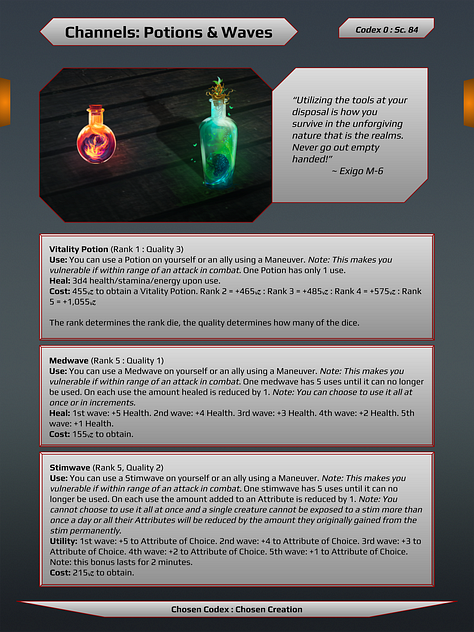
Enhancements:
As a Chosen, you have the opportunity to become an Enhanced individual. Whether it be through being a Chron Prime, a Syn, or taking the Enhanced Origin. Enhancements are like Gear Pieces, but are designed to be accessible to those with Enhancement Slots.
In order to place an Enhancement into an open slot, you must either find a Calibrator or have the Calibrate Enhancement already equipped into one of your slots.


If you are to become an Enhanced later in game, it comes at a price. When losing a limb or requiring enhancement surgery, one of your Attribute Scores will be permanently reduced by the Enhancement Slot. Note: The score in question is at the Loremaster's discretion.
Gadgets:
All Gadgetry is usually developed by scientists across the realms. What makes them unique is how they are manufactured to be mass-produced for a singular purpose with no upgrades available to them. To start, we will go over the most notable of gadgets...
Codexes:
Throughout the CORE and even Arthadian Anthologies, more often than not a Codex will be mentioned. These are the most common of Gear Pieces, on the same level as having a smart phone in a first world country here on earth.
Codexes come in all different shapes and sizes, but each of them harbors specific entries that the owner has been able to acquire. For how Codexes came about, listen to the Podcast Entry on Mortexian Philosophy.
Getting back to it - each codex is designed for information gathering, communications, identity, and a unique technical advantage for your Chosen to utilize.
Pillar Codex: Allows access to information regarding a specific Pillar. Note: You gain Advantage on any Lore check that involves a Pillar.
Hacking Codex: Allows you the ability to hack into computer systems with ease Note: You gain Advantage on any Computers/Coding check that involves Hacking.
Mission Codex: Allows you to see and choose any Mission that is posted by the Factions. Note: Your LM will grant a list from the Mission Archive.
Research Codex: Allows for you to gain insight into a specific subject. Note: You gain Advantage on a single Intellect Knowledge check for the day.
Scanning Codex: Allows for you to scan objects and people to understand them better. Note: You gain Advantage on Analyze/Straight Intellect checks.
Gadgets & Gadgeteers:
From within the Scientific community, there are some engineers that enjoy crafting unique pieces of Gear that could be mass distributed across the realms.
A Gadget, like the ones you will find on the scan presented, is crafted from scientists and technicians to aid in different scenarios. Even weapons are considered gadgets in some way, but gadgets are highly unique in their capabilities. Note: NO gadgets can be upgraded as they are always at their highest rank & quality.
You can also become a renowned Gadgeteer by obtaining the Craft (Intellect) Knowledge and crafting your own gear.
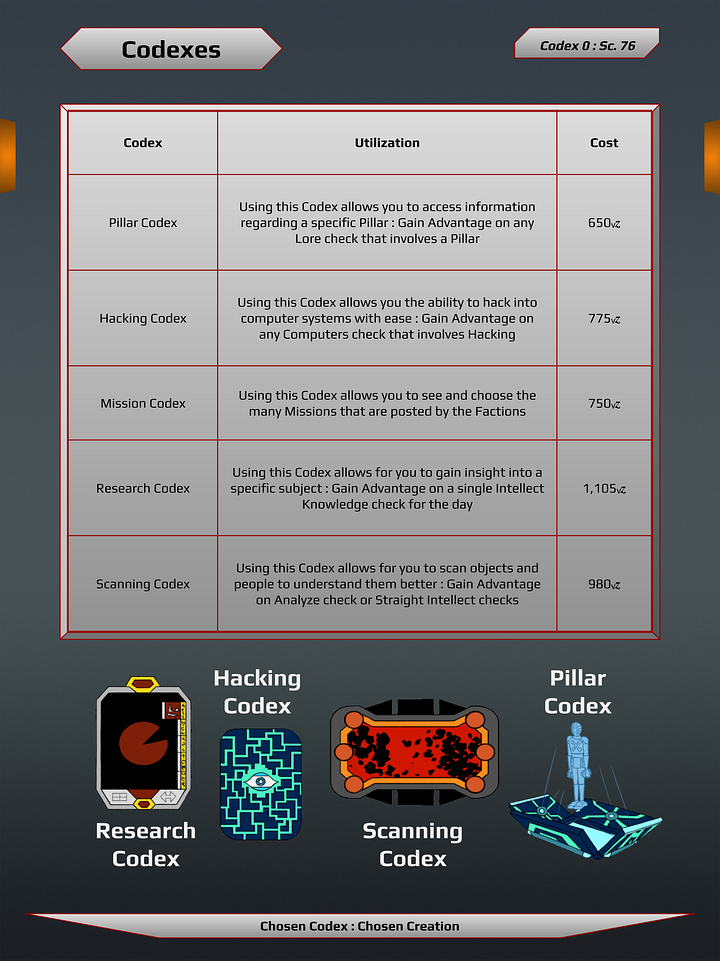
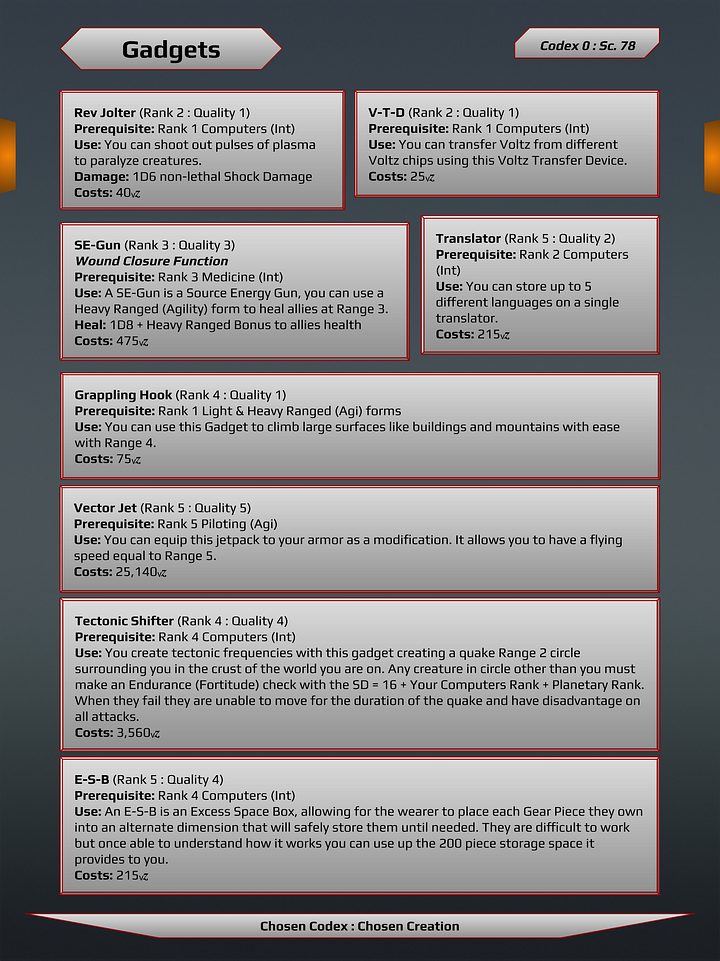
Packs & Kits:
When traveling the many worlds of the CORE, you will need to have at least one Pack and/or Kit with you to handle certain scenarios. Each Pack comes with 10 Gear Slots in which you can 'pack' your equipment into.
They allow for storage and easy access to stims, codexes, currencies, gadgets, and other necessary items. You can buy just a regular pack with no Gear in it that will only cost 215ᵥ𝒛. Note: They are all the same Rank and Quality: Rank 5 : Quality 2.
As for Kits, they are made for specific uses, having a specified amount of uses until they must be restocked. Note: requires materials to use.

Stations:
Throughout the entire Gear Archive, some pieces require stations to help maintain their quality & quantity. That's why as you explore different locations, some places will have Repair Stations, Med Bays, and more.
But what do you do if you have no time to search for a station, or if your spacecraft is miles away and you have no means of instant transportation? That's where Portable Stations come into play!
Each one will transform from a portable device into an area where you may work on a specific task. You will require materials to maintain each station based off of the task.
Weaponry:
The final category is the largest one, with all the weapons used through Offensive Forms. See the Combat Phase for more information.
Offensive Forms:
Each Weapon corresponds to a specific Offensive Form. Whenever you use a weapon, you will roll the corresponding Form check as an Attack roll on your Action Stage (Turn). The Offensive Forms are as follows:
Brawl (Strength): Hand to hand combat, this form allows users to understand basic martial talent, as well as the ability to wield a range of glove type weapons.
Light Weapons (Agility): Daggers, knives, whips, and any special weapons that are considered light use this Offensive Form.
Medium Weapons (Agility/Strength): Wielding a melee weapon that can be used with one hand or both hands.
Heavy Weapons (Strength): Large melee weapons that must be held tightly with both hands in order to wield.
Light Ranged (Agility): Pistols, Handguns, Grenades, etc… Anything that is considered a close ranged attack is a Light Ranged check.
Heavy Ranged (Agility/Strength): Large, two handed ranged weapons that can be shot from a long distance.
Weapon Attacks:
When using a Weapon there are two steps to the process.
First: Roll your Offensive Form against a Set Difficulty (SD) or Defensive Form. If you roll higher then your attack hits.
Second: Once it is determined that your attack hits, you can then roll for Damage: adding together the Weapons Damage + Offensive Form Bonus + Any Added Bonuses.
Form Bonus:
If mentioned, the Form Bonus allows you to add the Form's Rank + Talent (if applicable). Note: DO NOT add Attributes.
